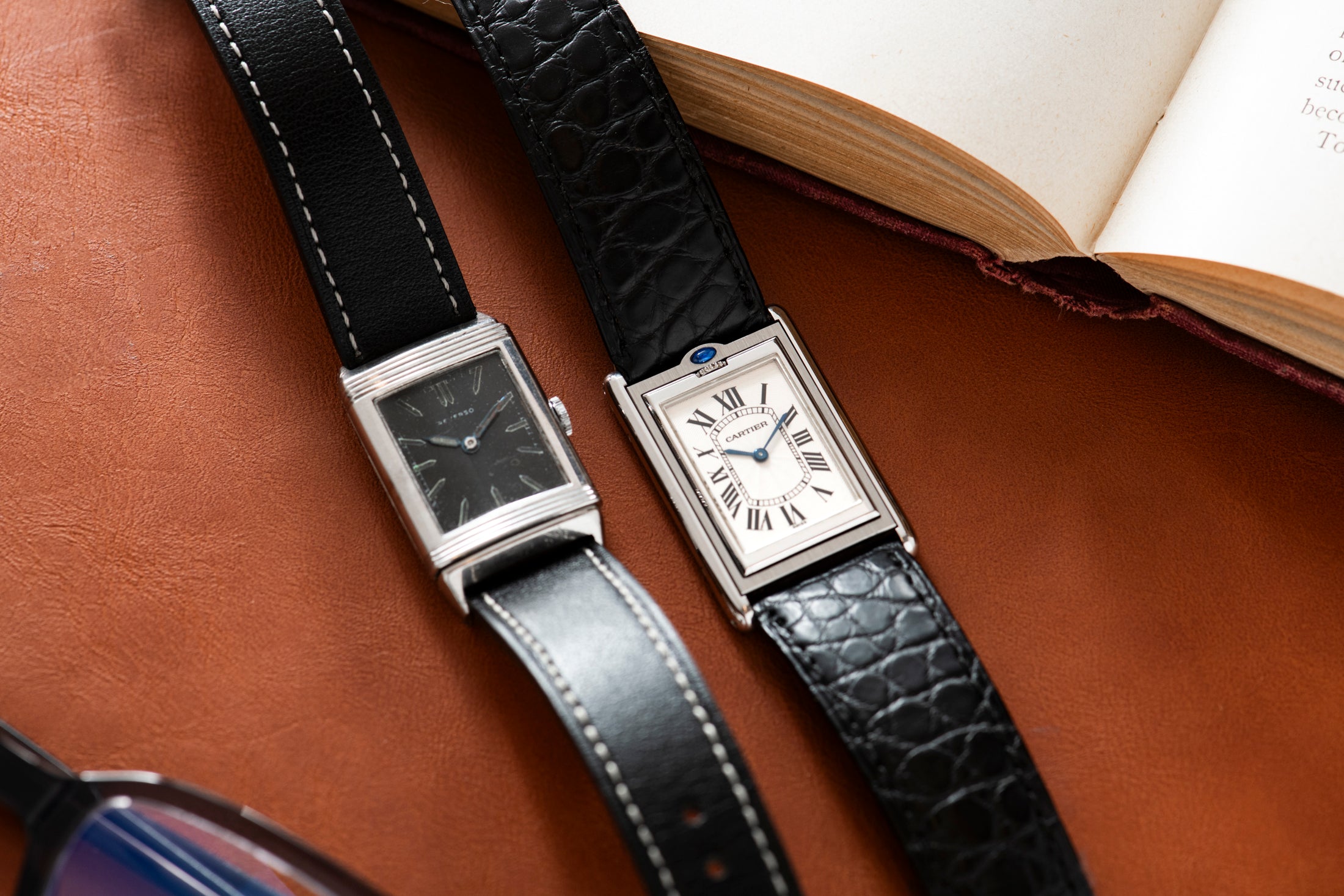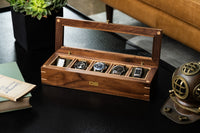There’s no denying that in the 21st century, a mechanical timepiece is a luxury.
Whether you spring for an inexpensive, mall-bought watch or the most exclusive F.P. Journe, it’s because you’ve consciously decided to move against the digital grain and opt for something that’s historically, nostalgically, mechanically, or emotionally different.
In this new reality, it’s sometimes difficult to remember that in the past, mechanical watches were a necessity — one wherein several exciting designs were born as practical solutions to real-world problems confronting everyday people. Today, we’re taking a closer look at two examples of this phenomenon, the Jaeger-LeCoultre Reverso and the Cartier Tank Basculante. In the early part of the 20th century, both of these models were developed in order to protect the sensitive watch crystal from breakage. Today, sapphire crystal has rendered their unique case-flipping mechanisms obsolete, but production of the Reverso continues apace, and the Basculante is still worn and appreciated. Ironically, both models are now considered dress (or dressier) watches.
Which should you buy?
History of the Reverso and Basculante
The stories of the Reverso and Basculante begin in the same way.

As many collectors know, the Reverso was developed to protect the delicate watch crystal while playing polo. In the early 1930s, César de Trey, a Swiss entrepreneur and watch enthusiast, attended a polo match between British soldiers in India. According to horological lore, after one of the soldiers broke the crystal of his wristwatch, de Trey was challenged to come up with an invention that would prevent such damage from occurring. De Trey took the casual challenge seriously and reached out to Jacques-David LeCoultre, who managed LeCoultre at the time. (At this point in history, LeCoultre was a movement parts manufacturer, one that built individual components to supply to the biggest names in the industry.) LeCoultre then turned to French designer Réne-Alfred Chauvot to design a reversible-case watch that would flip over, exposing a caseback and protecting the crystal.

The Revero's original patent and drawing - (Image by Time and Watches)
In 1931, Chauvot patented this system, which was dubbed “Reverso.” César de Trey then purchased the patent from Chauvot, establishing Spécialités Horlogères S.A. with LeCoultre in the process in order to distribute designs produced by LeCoultre and Jaeger S.A, a Parisian firm founded by Edmun Jaeger. By 1937, LeCoultre and Jaeger S.A. merged, and Jaeger-LeCoultre was born.

Patek Philippe Ref. 106 - (Image by Collector Square)
Thus not only did the Reverso provide an innovative solution to a practical issue, but was actually the impetus for JLC’s formation. The model is not only iconic because of its functionality, but equally as a result of its historical significance for JLC. (Interestingly enough, as a result of a unique relationship LeCoultre had with Patek Philippe, eight Reverso cases were delivered to Patek in 1931-1932, to which the maison added its own dials. These Patek Reference 106 ‘Reversos’ are among the most compelling vintage watches in Patek’s history.) Moreover, the flippable case mechanism serves a dual purpose, allowing the caseback to be decorated with intricate enamel and other designs. This arrangement, whereby the case itself becomes a canvas for artistic expression and momentarily takes the place of the watch dial, is largely unique in watchmaking.

Jaeger-LeCoultre Reverso Duetto - IN THE SHOP
Since the early 1930s, Jaeger-LeCoultre has greatly expanded the Reverso collection, adding complications, different sizes, ladies’ models, duo-face models with two separate time zones, and much more. The watch remains an icon within the JLC brand and the industry at large, and forms the basis of much of the maison’s production. In fact, after falling out of favor in the mid-20th century, it did much to buoy the brand’s business during the Quartz Crisis.

Cartier 'Cabriolet' yellow gold reversible watch - (Image by Sotheby's)
In 1932, shortly after the introduction of the Reverso, Cartier released the Basculante, a watch referred to originally as the Cabriolet. The first Tank-style watch to be offered in steel — fitting given its sporty remit — its case was contracted to Jaeger and de Tray’s own manufacturing firm, Spécialités Horlogères S.A. Thus, the Reverso and Basculante share the same DNA, and are deeply interconnected. (Interestingly, the Basculante was not the first watch Cartier made with built-in crystal protection — that honor would go to the Tank Obus Savonnette, which was released some years prior in the late 1920s.)

Cartier Tank Basculante Mécanique 150 Anniversary Limited Edition - IN THE SHOP
Unlike the Reverso, which was (and is) JLC’s flagship product, the Basculante was extremely rare. Cartier made very few Tanks of any kind prior to 1960, and the Basculante was just a small subset of this already-limited Tank production. By the 1990s, Cartier was producing a number of Basculantes, but almost always, they were introduced as limited editions with small production numbers. To this day, even as Cartier has increased the production of the Tank substantially to serve a growing customer base, the Basculante has remained a relative rarity, and isn’t currently part of the maison’s catalog. This certainly gives it an added level of mystique.
Both the Reverso and the Basculante have now been around for nearly a century, and each is regarded as a special watch within its respective brand’s catalog — whether because of its defining role in starting a prominent company, or as a result of its rarity.
Design
We know that both the Reverso and the Basculante were initially produced by the same casemaker — so what exactly differentiates them? In short, the two have entirely different swivel mechanisms, which has led to different look and design choices.

Jaeger-LeCoultre Reverso - IN THE SHOP
The Reverso is designed with an extremely elaborate case, the original version of which comprised 23 different parts, the modern version, 55. In essence, a platform contains the lugs and the portion of the case that sits against the wrist; within this platform sits the ‘body’ of the watch. By pushing this inner portion sideways, the body releases from the case platform and can be flipped over, thus protecting the watch crystal and exposing a plain caseback.
Eventually, the advent of sapphire crystal — which is extremely hardy — rendered this system obsolete, and the Reverso took on the aspect of a dress watch as sportier timepieces gained popularity. JLC then developed Duetto or Duoface versions of the Reverso, which allowed for the display of an additional time zone. While the traditional version allows for a caseback design such as a miniaturized painting, the Duoface became extremely popular due to its use as an elegant travel watch.

Cartier Tank Basculante Mécanique - IN THE SHOP
Whereas the Reverso reverses horizontally, the Basculante flips vertically: A case frame is once again set against the wrist and an inner bracket extends out of this caseback, with the body of the case sitting within this bracket. This inner body can flip vertically within the bracket, which is then reset into the case frame. This mechanism is a bit more involved than that of the Reverso, but results in a watch with a slightly thinner profile. Also, it should be noted that the culture of caseback decoration present on the Reverso is generally not present for the Basculante. (Jaeger-LeCoultre even maintains an entire division within its atelier dedicated to caseback engravings.)
The Reverso was heavily influenced by the Art Deco styling of the 1930s, and this translated into horizontal gadroons on the mid-carriage of the watch, stylized numerals, and elongated lugs that wrap the wrist. Comparatively, the Basculante is largely a modification of the Tank rather than a watch with its own distinct styling. Thus, the dial, numerals, guilloché work and case profile — and, on more modern models, the signature Tank cabochon — are all reminiscent of those of a Tank Louis Cartier. The flipping mechanism is almost an accessory to the Tank design rather than an attempt at a completely separate model line and aesthetic.
Value Proposition

Jaeger-LeCoultre Reverso Duoface Day/Night 'Meteorite' - IN THE SHOP
Because the Reverso is still in production and constitutes a significant portion of Jaeger-LeCoultre’s output, there are myriad references to choose from. From simple, time-only models in quartz for ~$7,000 all the way up to ultra-complicated versions such as the Hybris Mechanica for well over $1M, the Reverso truly runs the price gamut. Buying pre-owned offers a terrific value proposition and opens the sub-$10,000 segment significantly, while vintage offers unique configurations that might no longer be available today — and the ever-desirable patina inherent in radium- and tritium-clad examples. Given the unique case-flipping mechanism, enduring design, and history inherent in the Reverso, even a basic model offers significant value.

Cartier Tank Basculante Mécanique 150th Anniversary Limited Edition - IN THE SHOP
The Basculante, meanwhile, is currently out of production, and thus certain references can command higher values — especially in precious metals. But still, because this unique Tank variant was produced in stainless steel, there are plenty of hand-wound examples available at roughly the $10,000 mark, and many quartz models available for much less. While more conventional versions of the Tank are largely a dime a dozen, the Basculante remains an enticing offshoot with a special feature all its own. As an alternative to the Reverso — which is a much more widely recognizable watch — the Basculante is an attractive proposition.
Which to Buy?

So — which is the right watch for you?
There are certainly a number of Cartier purists who are not fond of the Basculante, and who maintain that the maison should never have produced its own reversible watch. We would argue, however, that the Basculante has a completely separate identity than its more famous cousin. Indeed, the fact that the Reverso debuted first is no discredit to Cartier any more than the El Primero is a discredit to the Calibre 11. If Cartier had simply licensed the Reverso’s design and placed a different stamp on the dial, perhaps we’d feel differently.
But because the brand came out with an entirely different mechanical and stylistic approach to a flipping watch, the Basculante deserves respect. Indeed, while Apple released its operating system before Microsoft did, few would claim it was wrong for Microsoft to develop Windows. Microsoft and Apple have two different conceptions of what an operating system should look like, and the result is two different products geared to two different clients and personalities.

Cartier Tank Basculante Mécanique - IN THE SHOP
Whereas a Reverso could easily be a one-and-only JLC, the Basculante is a much more niche Cartier product. While this might be an appropriate buy for a certain type of first-time Cartier customer, for many others, a route that takes one through a more conventional Tank Louis Cariter, Américaine, or Cintrée might be a safer bet. What’s certain is that those who appreciate under-the-radar models will find much to love in the Basculante. And as for the Reverso? It’s a classic model for a reason, beloved by collectors everywhere.

Jaeger-LeCoultre Reverso - IN THE SHOP
Given the storied history of both models, the value each affords, and the intrigue of these unique designs, which would you buy? Would you spring for the original classic — the Reverso, the watch that set the course for one of the most respected watch manufacturers in history? Or would you instead opt for the sleeper — the rare quirk in Cartier’s collection with a unique twist of mechanical interest?
Either way, you’ll be purchasing a timepiece that dates back to a time when watches were designed to address practical considerations customers were facing. Conceived to cater to a sporty clientele but achieving a reach extending far beyond what either brand could ever have imagined in the early 1900s, the Reverso and Basculante are both definitive classics, and are both deserving of a spot in your collection.













